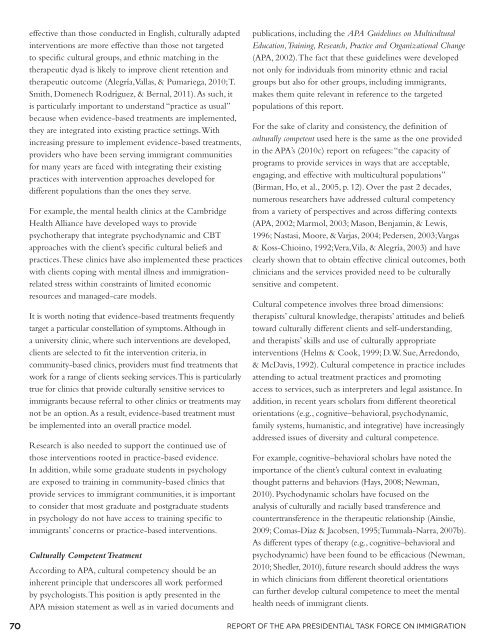Crossroads: The Psychology of Immigration in the New Century
Crossroads: The Psychology of Immigration in the New Century
Crossroads: The Psychology of Immigration in the New Century
You also want an ePaper? Increase the reach of your titles
YUMPU automatically turns print PDFs into web optimized ePapers that Google loves.
effective than those conducted <strong>in</strong> English, culturally adapted<br />
<strong>in</strong>terventions are more effective than those not targeted<br />
to specific cultural groups, and ethnic match<strong>in</strong>g <strong>in</strong> <strong>the</strong><br />
<strong>the</strong>rapeutic dyad is likely to improve client retention and<br />
<strong>the</strong>rapeutic outcome (Alegría, Vallas, & Pumariega, 2010; T.<br />
Smith, Domenech Rodríguez, & Bernal, 2011). As such, it<br />
is particularly important to understand “practice as usual”<br />
because when evidence-based treatments are implemented,<br />
<strong>the</strong>y are <strong>in</strong>tegrated <strong>in</strong>to exist<strong>in</strong>g practice sett<strong>in</strong>gs. With<br />
<strong>in</strong>creas<strong>in</strong>g pressure to implement evidence-based treatments,<br />
providers who have been serv<strong>in</strong>g immigrant communities<br />
for many years are faced with <strong>in</strong>tegrat<strong>in</strong>g <strong>the</strong>ir exist<strong>in</strong>g<br />
practices with <strong>in</strong>tervention approaches developed for<br />
different populations than <strong>the</strong> ones <strong>the</strong>y serve.<br />
For example, <strong>the</strong> mental health cl<strong>in</strong>ics at <strong>the</strong> Cambridge<br />
Health Alliance have developed ways to provide<br />
psycho<strong>the</strong>rapy that <strong>in</strong>tegrate psychodynamic and CBT<br />
approaches with <strong>the</strong> client’s specific cultural beliefs and<br />
practices. <strong>The</strong>se cl<strong>in</strong>ics have also implemented <strong>the</strong>se practices<br />
with clients cop<strong>in</strong>g with mental illness and immigrationrelated<br />
stress with<strong>in</strong> constra<strong>in</strong>ts <strong>of</strong> limited economic<br />
resources and managed-care models.<br />
It is worth not<strong>in</strong>g that evidence-based treatments frequently<br />
target a particular constellation <strong>of</strong> symptoms. Although <strong>in</strong><br />
a university cl<strong>in</strong>ic, where such <strong>in</strong>terventions are developed,<br />
clients are selected to fit <strong>the</strong> <strong>in</strong>tervention criteria, <strong>in</strong><br />
community-based cl<strong>in</strong>ics, providers must f<strong>in</strong>d treatments that<br />
work for a range <strong>of</strong> clients seek<strong>in</strong>g services. This is particularly<br />
true for cl<strong>in</strong>ics that provide culturally sensitive services to<br />
immigrants because referral to o<strong>the</strong>r cl<strong>in</strong>ics or treatments may<br />
not be an option. As a result, evidence-based treatment must<br />
be implemented <strong>in</strong>to an overall practice model.<br />
Research is also needed to support <strong>the</strong> cont<strong>in</strong>ued use <strong>of</strong><br />
those <strong>in</strong>terventions rooted <strong>in</strong> practice-based evidence.<br />
In addition, while some graduate students <strong>in</strong> psychology<br />
are exposed to tra<strong>in</strong><strong>in</strong>g <strong>in</strong> community-based cl<strong>in</strong>ics that<br />
provide services to immigrant communities, it is important<br />
to consider that most graduate and postgraduate students<br />
<strong>in</strong> psychology do not have access to tra<strong>in</strong><strong>in</strong>g specific to<br />
immigrants’ concerns or practice-based <strong>in</strong>terventions.<br />
Culturally Competent Treatment<br />
Accord<strong>in</strong>g to APA, cultural competency should be an<br />
<strong>in</strong>herent pr<strong>in</strong>ciple that underscores all work performed<br />
by psychologists. This position is aptly presented <strong>in</strong> <strong>the</strong><br />
APA mission statement as well as <strong>in</strong> varied documents and<br />
publications, <strong>in</strong>clud<strong>in</strong>g <strong>the</strong> APA Guidel<strong>in</strong>es on Multicultural<br />
Education, Tra<strong>in</strong><strong>in</strong>g, Research, Practice and Organizational Change<br />
(APA, 2002). <strong>The</strong> fact that <strong>the</strong>se guidel<strong>in</strong>es were developed<br />
not only for <strong>in</strong>dividuals from m<strong>in</strong>ority ethnic and racial<br />
groups but also for o<strong>the</strong>r groups, <strong>in</strong>clud<strong>in</strong>g immigrants,<br />
makes <strong>the</strong>m quite relevant <strong>in</strong> reference to <strong>the</strong> targeted<br />
populations <strong>of</strong> this report.<br />
For <strong>the</strong> sake <strong>of</strong> clarity and consistency, <strong>the</strong> def<strong>in</strong>ition <strong>of</strong><br />
culturally competent used here is <strong>the</strong> same as <strong>the</strong> one provided<br />
<strong>in</strong> <strong>the</strong> APA’s (2010c) report on refugees: “<strong>the</strong> capacity <strong>of</strong><br />
programs to provide services <strong>in</strong> ways that are acceptable,<br />
engag<strong>in</strong>g, and effective with multicultural populations”<br />
(Birman, Ho, et al., 2005, p. 12). Over <strong>the</strong> past 2 decades,<br />
numerous researchers have addressed cultural competency<br />
from a variety <strong>of</strong> perspectives and across differ<strong>in</strong>g contexts<br />
(APA, 2002; Marmol, 2003; Mason, Benjam<strong>in</strong>, & Lewis,<br />
1996; Nastasi, Moore, & Varjas, 2004; Pedersen, 2003; Vargas<br />
& Koss-Chio<strong>in</strong>o, 1992; Vera, Vila, & Alegría, 2003) and have<br />
clearly shown that to obta<strong>in</strong> effective cl<strong>in</strong>ical outcomes, both<br />
cl<strong>in</strong>icians and <strong>the</strong> services provided need to be culturally<br />
sensitive and competent.<br />
Cultural competence <strong>in</strong>volves three broad dimensions:<br />
<strong>the</strong>rapists’ cultural knowledge, <strong>the</strong>rapists’ attitudes and beliefs<br />
toward culturally different clients and self-understand<strong>in</strong>g,<br />
and <strong>the</strong>rapists’ skills and use <strong>of</strong> culturally appropriate<br />
<strong>in</strong>terventions (Helms & Cook, 1999; D. W. Sue, Arredondo,<br />
& McDavis, 1992). Cultural competence <strong>in</strong> practice <strong>in</strong>cludes<br />
attend<strong>in</strong>g to actual treatment practices and promot<strong>in</strong>g<br />
access to services, such as <strong>in</strong>terpreters and legal assistance. In<br />
addition, <strong>in</strong> recent years scholars from different <strong>the</strong>oretical<br />
orientations (e.g., cognitive–behavioral, psychodynamic,<br />
family systems, humanistic, and <strong>in</strong>tegrative) have <strong>in</strong>creas<strong>in</strong>gly<br />
addressed issues <strong>of</strong> diversity and cultural competence.<br />
For example, cognitive–behavioral scholars have noted <strong>the</strong><br />
importance <strong>of</strong> <strong>the</strong> client’s cultural context <strong>in</strong> evaluat<strong>in</strong>g<br />
thought patterns and behaviors (Hays, 2008; <strong>New</strong>man,<br />
2010). Psychodynamic scholars have focused on <strong>the</strong><br />
analysis <strong>of</strong> culturally and racially based transference and<br />
countertransference <strong>in</strong> <strong>the</strong> <strong>the</strong>rapeutic relationship (A<strong>in</strong>slie,<br />
2009; Comas-Díaz & Jacobsen, 1995; Tummala-Narra, 2007b).<br />
As different types <strong>of</strong> <strong>the</strong>rapy (e.g., cognitive–behavioral and<br />
psychodynamic) have been found to be efficacious (<strong>New</strong>man,<br />
2010; Shedler, 2010), future research should address <strong>the</strong> ways<br />
<strong>in</strong> which cl<strong>in</strong>icians from different <strong>the</strong>oretical orientations<br />
can fur<strong>the</strong>r develop cultural competence to meet <strong>the</strong> mental<br />
health needs <strong>of</strong> immigrant clients.<br />
70 Report <strong>of</strong> <strong>the</strong> APA Presidential Task Force on <strong>Immigration</strong>
















